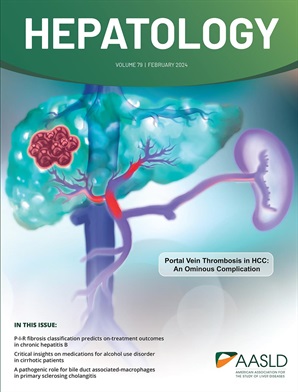Reclassifying pediatric NAFLD using the steatotic liver disease framework: a multicenter retrospective study from the NASH CRN.
IF 15.8
1区 医学
Q1 GASTROENTEROLOGY & HEPATOLOGY
引用次数: 0
Abstract
BACKGROUND AIMS The terminology for hepatic steatosis and nonalcoholic fatty liver disease (NAFLD) was revised under the umbrella of steatotic liver disease (SLD), with metabolic dysfunction-associated steatotic liver disease (MASLD) as the primary subtype. MASLD is defined by hepatic steatosis plus at least one cardiometabolic risk factor (CMRF). A new category, Met-ALD, describes MASLD with alcohol consumption below the defined thresholds for alcohol-associated liver disease (ALD). While adult studies have demonstrated strong concordance between NAFLD and MASLD, the applicability of this framework in children remains unclear. APPROACH RESULTS We assessed children clinically diagnosed with NAFLD and enrolled in the NASH CRN who had available liver histology. Clinical and demographic data, including body mass index (BMI), hepatotoxic medication use, and alcohol intake, were analyzed. Liver biopsies were centrally reviewed to confirm hepatic steatosis and evaluate for alternative etiologies. Participants were reclassified using the SLD framework. Among 1,019 children diagnosed with NAFLD, 858 (84%) met MASLD criteria. The average number of CMRFs per participant was 2.7±1.1; 41 (4.7%) met all five. Thirty-three participants (3.2%) were reclassified as Met-ALD, a prevalence that rose to 5.4% among adolescents. Sixty-six children (6.5%) were reclassified as drug-induced SLD. CONCLUSIONS Most children with NAFLD met MASLD criteria, but nearly 1 in 6 were reclassified based on alcohol use or medication exposure. These findings highlight the need for a systematic diagnostic approach accounting for metabolic risk factors, alcohol use, and medication-related liver injury.使用脂肪变性肝病框架对儿童NAFLD进行重新分类:来自NASH CRN的多中心回顾性研究
背景目的:肝脏脂肪变性和非酒精性脂肪性肝病(NAFLD)的术语在脂肪变性肝病(SLD)的框架下进行了修订,并将代谢功能障碍相关脂肪性肝病(MASLD)作为主要亚型。MASLD的定义是肝脂肪变性加上至少一种心脏代谢危险因素(CMRF)。一个新的分类,Met-ALD,描述了酒精摄入量低于酒精相关肝病(ALD)定义阈值的MASLD。虽然成人研究表明NAFLD和MASLD之间有很强的一致性,但这一框架在儿童中的适用性尚不清楚。方法结果:我们评估了临床诊断为NAFLD的儿童,并纳入了NASH CRN,这些儿童有可用的肝脏组织学。分析临床和人口统计数据,包括体重指数(BMI)、肝毒性药物使用和酒精摄入量。肝脏活检被集中检查以确认肝脂肪变性和评估其他病因。使用SLD框架对参与者进行重新分类。在1019名被诊断为NAFLD的儿童中,858名(84%)符合MASLD标准。每名参与者的平均cmrf数为2.7±1.1;41人(4.7%)满足所有5项要求。33名参与者(3.2%)被重新归类为Met-ALD,青少年患病率上升至5.4%。66例(6.5%)患儿被重新归类为药物性SLD。结论:大多数NAFLD患儿符合MASLD标准,但近六分之一的患儿因饮酒或药物暴露被重新分类。这些发现强调需要一种系统的诊断方法来考虑代谢危险因素、酒精使用和药物相关的肝损伤。
本文章由计算机程序翻译,如有差异,请以英文原文为准。
求助全文
约1分钟内获得全文
求助全文
来源期刊

Hepatology
医学-胃肠肝病学
CiteScore
27.50
自引率
3.70%
发文量
609
审稿时长
1 months
期刊介绍:
HEPATOLOGY is recognized as the leading publication in the field of liver disease. It features original, peer-reviewed articles covering various aspects of liver structure, function, and disease. The journal's distinguished Editorial Board carefully selects the best articles each month, focusing on topics including immunology, chronic hepatitis, viral hepatitis, cirrhosis, genetic and metabolic liver diseases, liver cancer, and drug metabolism.
 求助内容:
求助内容: 应助结果提醒方式:
应助结果提醒方式:


